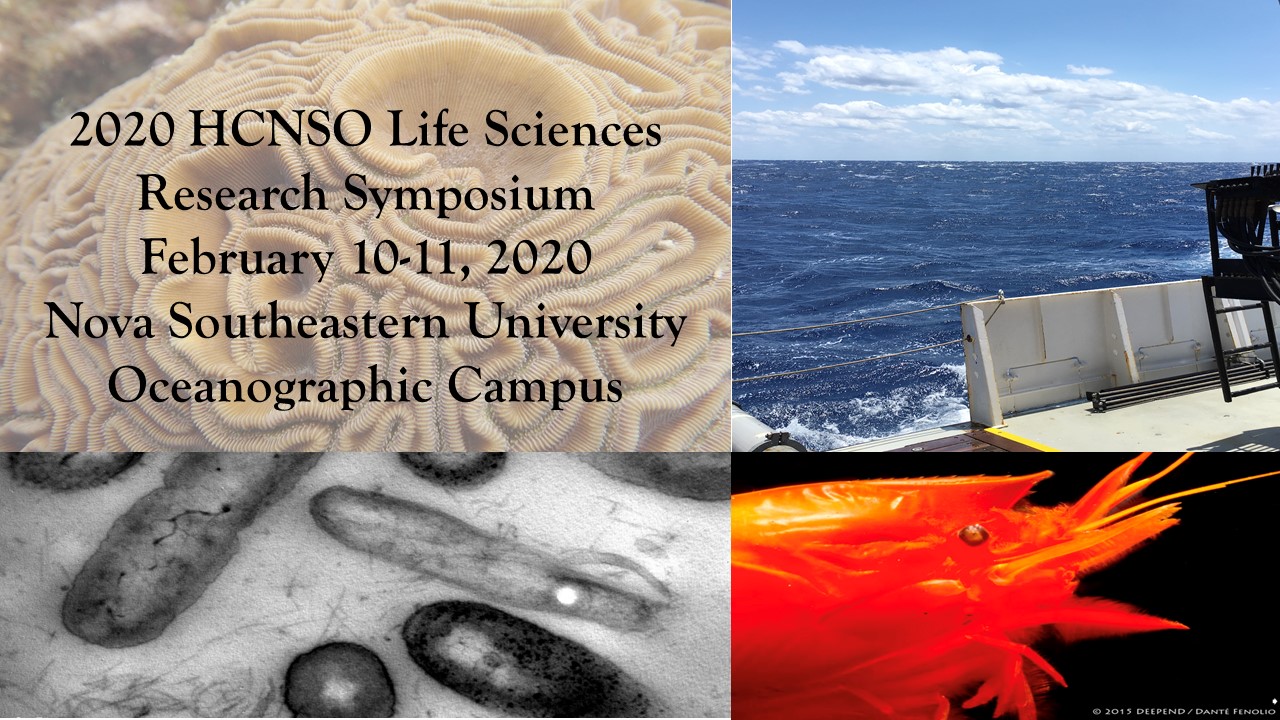Microbial Analysis of Surfactant-Associated Bacteria in the Sea Surface Microlayer and Remote Sensing of Associated Slicks
Location
HCNSO Guy Harvey Oceanographic Center Nova Southeastern University
Start
2-11-2020 11:30 AM
End
2-11-2020 11:45 AM
Type of Presentation
Oral Presentation
Abstract
Microbial Analysis of Surfactant-Associated Bacteria in the Sea Surface Microlayer and Remote Sensing of Associated Slicks
Georgia Parks1, Cayla W. Dean1, John A. Kluge1, Alexander V. Soloviev1, Mahmood Shivji1, Aurelien Tartar2, Kathryn L. Howe3, Susanne Lehner4, Egbert Schwarz4, Hui Shen5, William Perrie5, Paul Schuler6
1Nova Southeastern University, Halmos College of Natural Sciences and Oceanography, Dania Beach, FL, USA
2Nova Southeastern University, Department of Biological Sciences, Davie, FL, USA
3Florida State University, Tallahassee, FL, USA
4German Aerospace Center (DLR) Remote Sensing Technology Institute, Oberpfaffenhofen, Germany
5Bedford Institute of Oceanography, Bedford, NS, Canada
6Oil Spill Response Limited, Fort Lauderdale, FL, USA
The sea-surface microlayer (SML) is the boundary layer at the air-sea interface where many biogeochemical processes occur. Many organisms (e.g., bacteria) produce surface active agents (surfactants) for life processes, which accumulate in the SML and dampen short gravity-capillary waves, resulting in sea surface slicks. Synthetic aperture radar (SAR) is capable of remotely sensing these features on the sea surface by measuring reflected backscatter from the ocean surface in microwaves. This study coordinates SAR overpasses with in situ SML and subsurface (SSW) microbial sample collection to guide subsequent analysis after 16s rRNA sequencing on the Illumina MiSeq. In April 2017, 138 SML and SSW samples were collected near a targeted oil-seep where the Taylor Platform was knocked down in the Gulf of Mexico, both in and out of visually-observed oil slicks. In July and August 2018, 220 SML and SSW samples were collected near the Looe Key coral reef and a coastal seagrass area. Analysis of microbial abundance and diversity between the two experiments shows that within oil slicks, surfactant- and oil-associated bacteria prefer to reside within the SSW rather than in the SML. In natural slicks in the coastal seagrass area, these bacteria are more abundant in the SML. Outside of these slicks, surfactant-associated bacteria are more abundant within the SML than the SSW. This suggests that the presence of oil reduces the habitability of the SML, whereas natural slicks created by foam and other surfactants creates a more habitable environment in the SML. With lower wind speed, abundance of these bacteria are greater, as increased wind speed results in a harsher environment. The diurnal cycle had an effect on the relative abundance of surfactant-associated bacteria in the SML and SSW. Our results demonstrate the usefulness of synthetic aperture radar to remotely sense sea surface slicks in coordination with in situ surfactant-associated bacteria data collection of the sea surface slicks.
Microbial Analysis of Surfactant-Associated Bacteria in the Sea Surface Microlayer and Remote Sensing of Associated Slicks
HCNSO Guy Harvey Oceanographic Center Nova Southeastern University
Microbial Analysis of Surfactant-Associated Bacteria in the Sea Surface Microlayer and Remote Sensing of Associated Slicks
Georgia Parks1, Cayla W. Dean1, John A. Kluge1, Alexander V. Soloviev1, Mahmood Shivji1, Aurelien Tartar2, Kathryn L. Howe3, Susanne Lehner4, Egbert Schwarz4, Hui Shen5, William Perrie5, Paul Schuler6
1Nova Southeastern University, Halmos College of Natural Sciences and Oceanography, Dania Beach, FL, USA
2Nova Southeastern University, Department of Biological Sciences, Davie, FL, USA
3Florida State University, Tallahassee, FL, USA
4German Aerospace Center (DLR) Remote Sensing Technology Institute, Oberpfaffenhofen, Germany
5Bedford Institute of Oceanography, Bedford, NS, Canada
6Oil Spill Response Limited, Fort Lauderdale, FL, USA
The sea-surface microlayer (SML) is the boundary layer at the air-sea interface where many biogeochemical processes occur. Many organisms (e.g., bacteria) produce surface active agents (surfactants) for life processes, which accumulate in the SML and dampen short gravity-capillary waves, resulting in sea surface slicks. Synthetic aperture radar (SAR) is capable of remotely sensing these features on the sea surface by measuring reflected backscatter from the ocean surface in microwaves. This study coordinates SAR overpasses with in situ SML and subsurface (SSW) microbial sample collection to guide subsequent analysis after 16s rRNA sequencing on the Illumina MiSeq. In April 2017, 138 SML and SSW samples were collected near a targeted oil-seep where the Taylor Platform was knocked down in the Gulf of Mexico, both in and out of visually-observed oil slicks. In July and August 2018, 220 SML and SSW samples were collected near the Looe Key coral reef and a coastal seagrass area. Analysis of microbial abundance and diversity between the two experiments shows that within oil slicks, surfactant- and oil-associated bacteria prefer to reside within the SSW rather than in the SML. In natural slicks in the coastal seagrass area, these bacteria are more abundant in the SML. Outside of these slicks, surfactant-associated bacteria are more abundant within the SML than the SSW. This suggests that the presence of oil reduces the habitability of the SML, whereas natural slicks created by foam and other surfactants creates a more habitable environment in the SML. With lower wind speed, abundance of these bacteria are greater, as increased wind speed results in a harsher environment. The diurnal cycle had an effect on the relative abundance of surfactant-associated bacteria in the SML and SSW. Our results demonstrate the usefulness of synthetic aperture radar to remotely sense sea surface slicks in coordination with in situ surfactant-associated bacteria data collection of the sea surface slicks.


